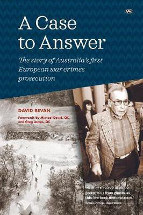A case to answer by David Bevan

Wakefield Press, 2018. ISBN 9781862543232
(Age: Senior secondary - Adult) Highly recommended. Re-released for
the 25th anniversary of the trial, A case to answer is a
thorough and objective account of the first European war crimes
prosecution held in Australia - where a quiet elderly man in
Adelaide's suburbs was arrested for participation in the murder and
massacre of Jewish civilians in Serniki, a village in Nazi occupied
Ukraine.
Amidst political controversy, Australia enacted the War Crimes
Amendment Bill in 1988 allowing for the prosecution of European war
criminals on Australian soil. And the first case pursued was the
case of Ivan Polyukhovich, a Ukrainian forester who was accused of
collaborating with the Nazis to kill the Jewish population of
Serniki. David Bevan was a court reporter for The Advertiser at the
time, and his book is an impartial record of the prosecution and
defence - he does not argue a case either way, but carefully records
the issues that were encountered by both sides. The book becomes a
fascinating document about the collection of evidence and the
problems of prosecuting or defending charges made by witnesses from
another country, another culture and language, 50 years after the
crimes were committed.
Bevan describes how, after many months of investigation, prosecutor
Grant Niemann gradually realised the familiarity of the types of
issues he had encountered in arguing claims on behalf of Aboriginal
communities in the Northern Territory in the 1980s - problems of
cultural misunderstandings, and of concepts and language alien to
the white legal system. The Ukrainian witnesses in the war crime
case also belonged to an entirely different culture, an essentially
oral society. They were fearful of authority and did not understand
the procedures of the legal system. Particularly interesting are the
problems of translation - the nuances of language that could use the
male pronoun for child regardless of gender, where clothing is
described as dark or light-coloured rather than a specific colour
differentiation, where the term morning implies daylight rather than
the hours after midnight, different meanings for the concept
'knowing', and different ways of using yes or no in agreement with a
question. These are the kinds of issues discovered by learners of
other languages but not part of the experience of an essentially
monolingual society and legal system.
The book describes the many legal issues of what constitutes
evidence - issues of identification, issues of uncorroborated or
varying accounts, as well as the question of how to test the
evidence after a period of 50 years when many people had died and
most of the village had been destroyed during the war and rebuilt in
the following years. Both the prosecuting and defence teams
travelled to the Ukraine to uncover the massacre site and to check
witness accounts. So much work went into the case, in the pursuit of
justice. Whether justice could ever be achieved remains in question.
I would recommend this books for students of law, history, and of
language and culture studies. It is a fascinating record that raises
many questions for discussion.
Helen Eddy